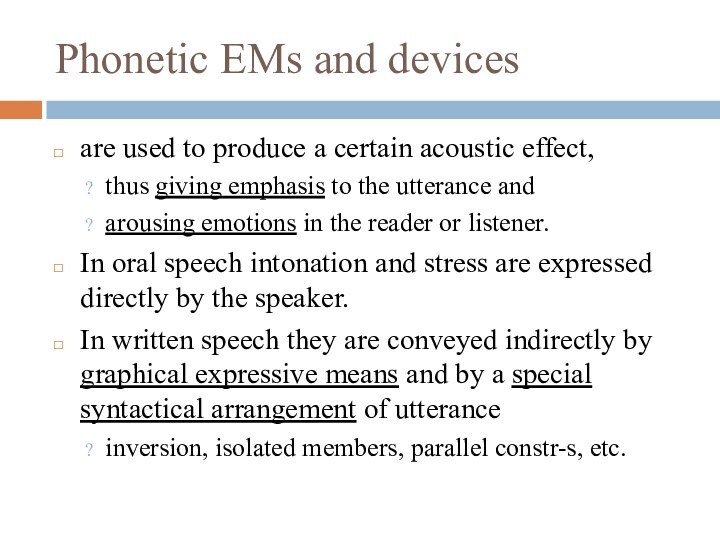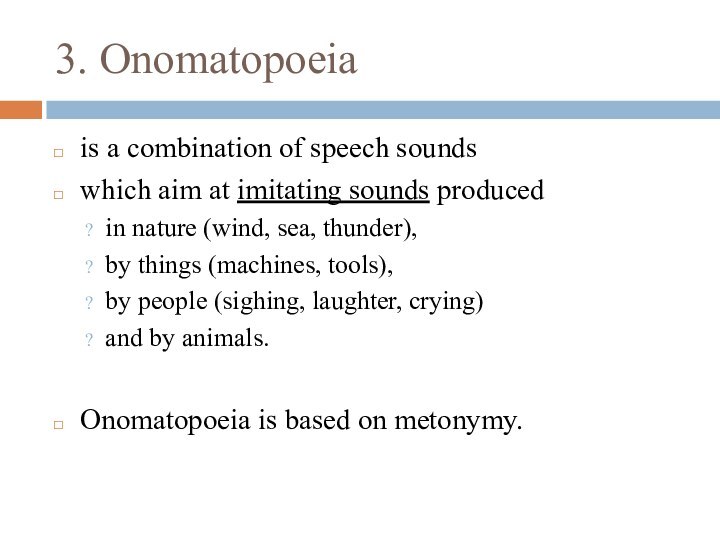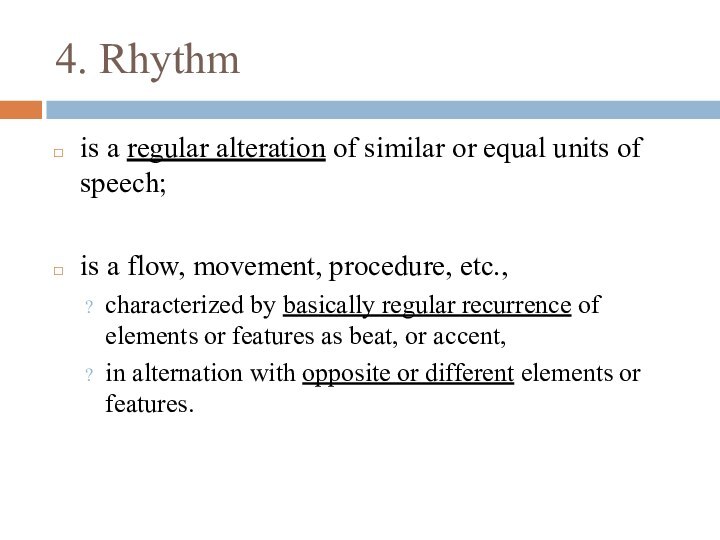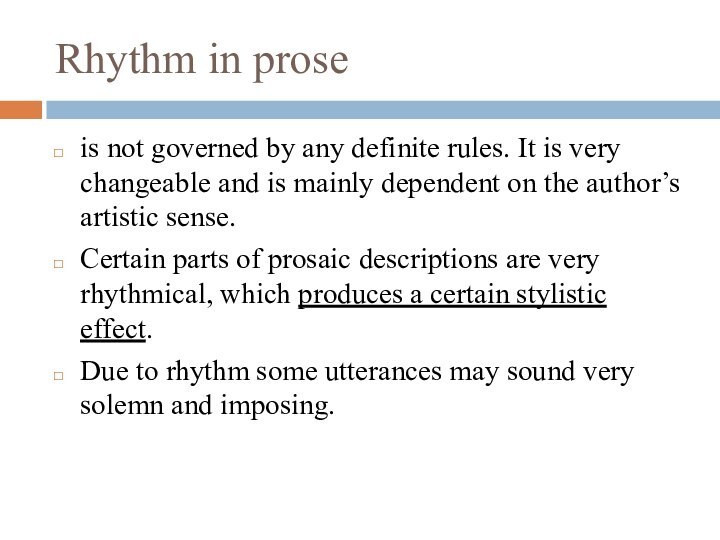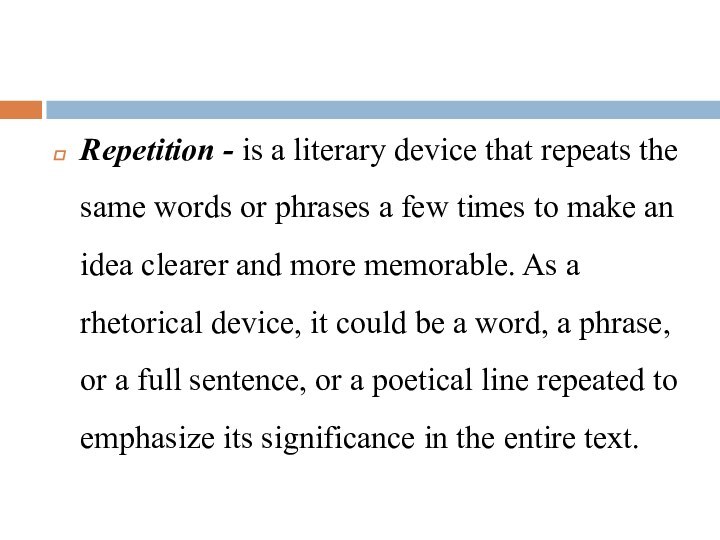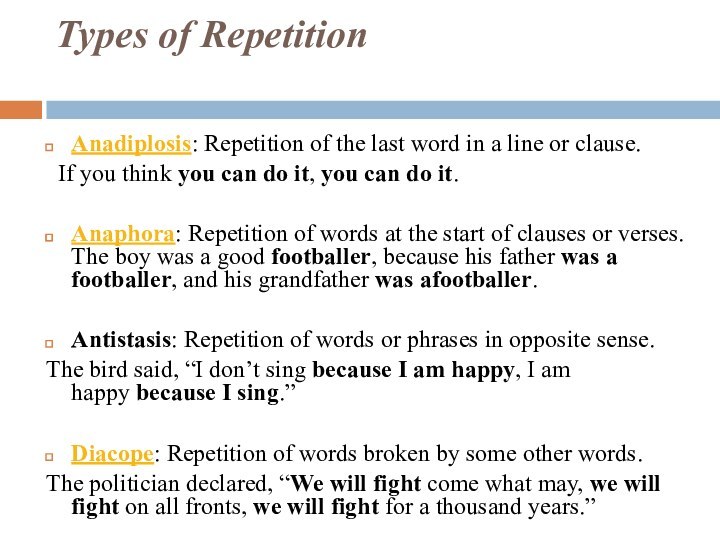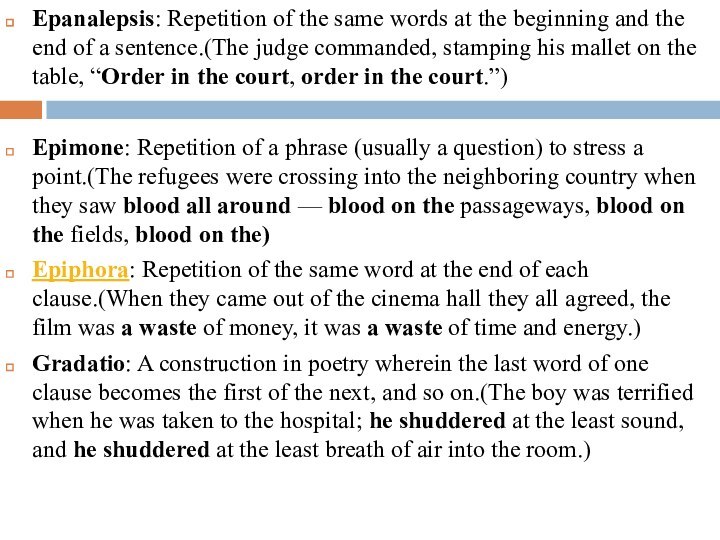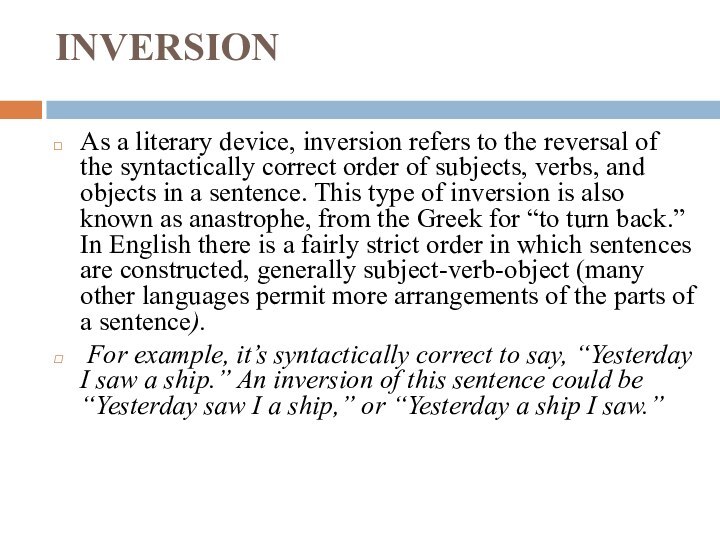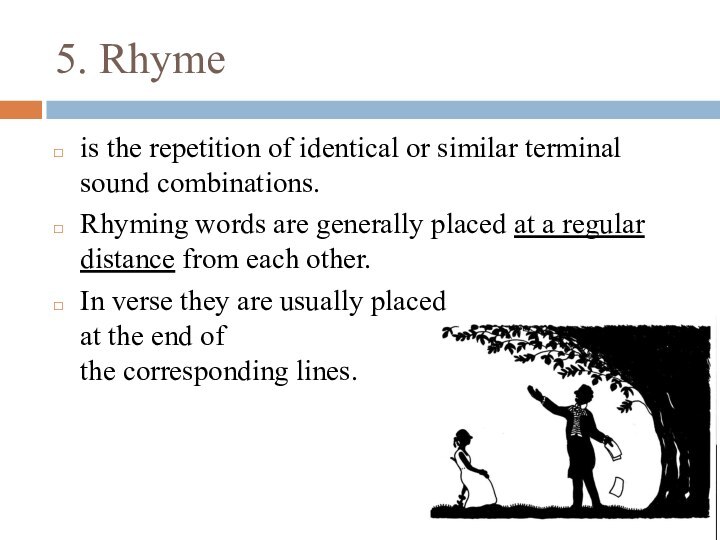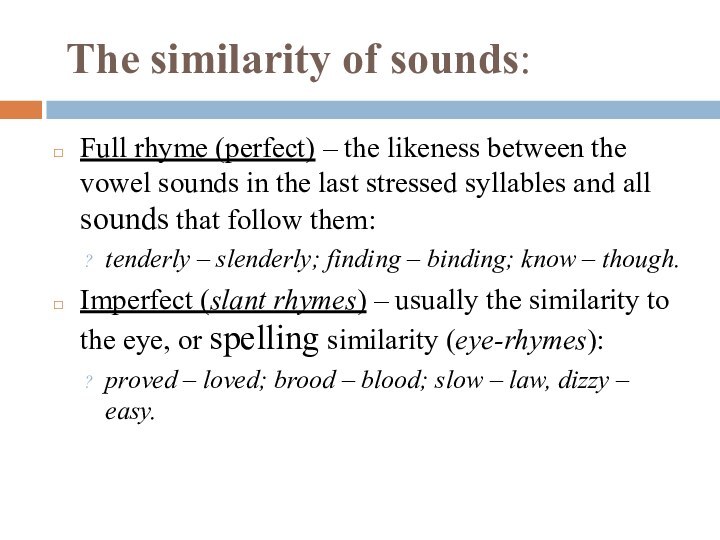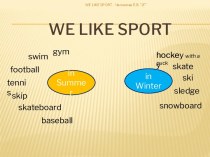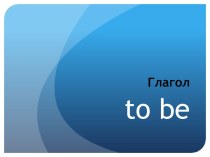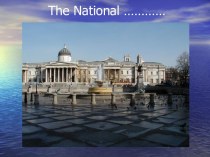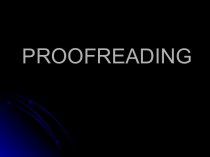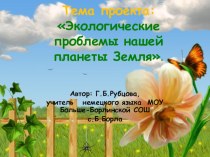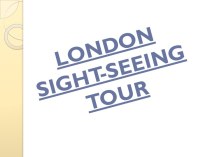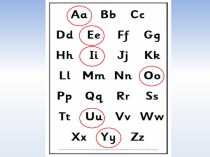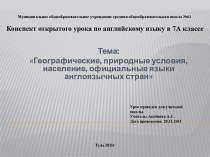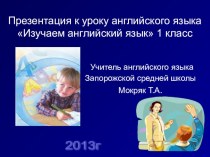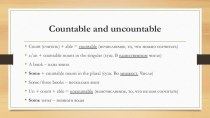Слайд 2
Phonetic EMs and devices
are used to produce
a certain acoustic effect,
thus giving emphasis to the utterance
and
arousing emotions in the reader or listener.
In oral speech intonation and stress are expressed directly by the speaker.
In written speech they are conveyed indirectly by graphical expressive means and by a special syntactical arrangement of utterance
inversion, isolated members, parallel constr-s, etc.
Слайд 3
Euphony
is such a combination of words and such
an arrangement of utterance
which produces a pleasing acoustic
effect.
Euphony is generally achieved
by such phonetic SDs as:
alliteration,
onomatopoeia,
rhythm and rhyme.
Слайд 4
1. Alliteration
- is a phonetic stylistic device,
which
aims at imparting a melodic effect to the utterance
by deliberate use of similar consonants in close succession
to achieve a euphonic effect.
- was a conventional device of OE poetry, which was based on alliteration.
Слайд 5
Alliteration
like most phonetic EMs, doesn’t bear any lexical
or other meaning, it is only a sort of
musical accompaniment of the utterance
Doubting, dreading, dreams no mortals
ever dared to dream before (Poe).
Hannah’s home has heat hopefully
Nick’s nephew needed new notebooks now not never
is widely used in folklore, proverbs, sayings, traditional pairs of words:
out of the frying pan into the fire;
safe and sound, as fit as a fiddle,
a pig in a poke, as busy as a bee
Слайд 6
Alliteration: used in
prose - a strong melodic and
emotional effect:
The possessive instinct never stands still (Gals.)
poetry:
The day
is cold and dark and dreary
It rains and the wind is never weary. (Longf.)
book titles:
School for Scandal (R. Sheridan), Pride and Prejudice, Sense and Sensibility (J. Austen), Silver Spoon (J. Galsworthy).
Слайд 7
2. Assonance
the repetition of vowel sounds to create internal rhyming within phrases or sentences (a
rhyme in this case being just the syllabic resemblance):
on
a proud round cloud in white high night;
I must confess that in my quest I felt depressed and restless;
Soft language issued from their spitless lips as they swished in low circles round and round the field, winding hither and thither through the weeds.
Слайд 8
3. Onomatopoeia
is a combination of speech sounds
which
aim at imitating sounds produced
in nature (wind, sea,
thunder),
by things (machines, tools),
by people (sighing, laughter, crying)
and by animals.
Onomatopoeia is based on metonymy.
Слайд 9
Onomatopoeia
is often based on and combined with alliteration;
may
carry on an aesthetic function:
act pleasurably or unpleasurably
on
the reader’s feelings.
is the poetic device by which sound is used to communicate sense.
The moan of doves in immemorial elms. And murmuring of innumerable bees.
Слайд 10
Onomatopoeia
Direct - is contained in words that imitate
natural sounds:
buzz, cuckoo, ding-dong…
Indirect - is a
combination of sounds, the aim of which is to make the sound of the utterance an echo of its sense (echo-writing):
And the silken, sad, uncertain, rustling of each purple curtain. (E.A. Poe)
Indirect O. demands some mention of what makes the sound., as rustling of curtains in the following line An example is:
And the silken, sad, uncertain rustling of... each purple curtain” (E. A. Poe),
where the repetition of the sound [s] actually produces the sound of the rustling of the curtain.
Слайд 11
4. Rhythm
is a regular alteration of similar or
equal units of speech;
is a flow, movement, procedure, etc.,
characterized by basically regular recurrence of elements or features as beat, or accent,
in alternation with opposite or different elements or features.
Слайд 12
Rhythm in prose
is not governed by any definite
rules. It is very changeable and is mainly dependent
on the author’s artistic sense.
Certain parts of prosaic descriptions are very rhythmical, which produces a certain stylistic effect.
Due to rhythm some utterances may sound very solemn and imposing.
Слайд 13
Rhythm in prose
is also created by more or
less recurrent repetition of some similar units of speech:
repetition
of all kinds,
polysyndeton,
asyndeton,
inversion,
parallelism;
heightens the emotional tension of the narration.
Слайд 14
Repetition - is a literary device that repeats
the same words or phrases a few times to
make an idea clearer and more memorable. As a rhetorical device, it could be a word, a phrase, or a full sentence, or a poetical line repeated to emphasize its significance in the entire text.
Слайд 15
Types of Repetition
Anadiplosis: Repetition of the last word
in a line or clause.
If you think you
can do it, you can do it.
Anaphora: Repetition of words at the start of clauses or verses. The boy was a good footballer, because his father was a footballer, and his grandfather was afootballer.
Antistasis: Repetition of words or phrases in opposite sense.
The bird said, “I don’t sing because I am happy, I am happy because I sing.”
Diacope: Repetition of words broken by some other words.
The politician declared, “We will fight come what may, we will fight on all fronts, we will fight for a thousand years.”
Слайд 16
Epanalepsis: Repetition of the same words at the
beginning and the end of a sentence.(The judge commanded,
stamping his mallet on the table, “Order in the court, order in the court.”)
Epimone: Repetition of a phrase (usually a question) to stress a point.(The refugees were crossing into the neighboring country when they saw blood all around — blood on the passageways, blood on the fields, blood on the)
Epiphora: Repetition of the same word at the end of each clause.(When they came out of the cinema hall they all agreed, the film was a waste of money, it was a waste of time and energy.)
Gradatio: A construction in poetry wherein the last word of one clause becomes the first of the next, and so on.(The boy was terrified when he was taken to the hospital; he shuddered at the least sound, and he shuddered at the least breath of air into the room.)
Слайд 17
INVERSION
As a literary device, inversion refers to the
reversal of the syntactically correct order of subjects, verbs,
and objects in a sentence. This type of inversion is also known as anastrophe, from the Greek for “to turn back.” In English there is a fairly strict order in which sentences are constructed, generally subject-verb-object (many other languages permit more arrangements of the parts of a sentence).
For example, it’s syntactically correct to say, “Yesterday I saw a ship.” An inversion of this sentence could be “Yesterday saw I a ship,” or “Yesterday a ship I saw.”
Слайд 18
Parallelism
Parallelism is the usage of repeating words and
forms to give pattern and rhythm to a passage in literature.
Parallelism often either juxtaposes contrasting images or ideas so as to show their stark difference, or joins similar concepts to show their connection.
What you see is what you get.
If you can’t beat them, join them.
A penny saved is a penny earned.
Easy come, easy go.
Слайд 19
5. Rhyme
is the repetition of identical or similar
terminal sound combinations.
Rhyming words are generally placed at
a regular distance from each other.
In verse they are usually placed
at the end of
the corresponding lines.
Слайд 20
“Baa baa black sheep, have you any wool?
Yes sir,
yes sir, three bags full!
One for the master, one for
the dame,
And one for the little boy who lives down the lane.”
“Humpty Dumpty sat on a wall,
Humpty Dumpty had a great fall.
All the King’s horses, And all the King’s men
Couldn’t put Humpty together again!”
Слайд 21
Rhyme
is one of the means of creating euphony.
In
poetry rhyme is considered to be quite normal;
in prose
it sounds pretty abnormal, is considered to be a violation of euphony.
Yet, some authors resort to rhyming in order to achieve a humorous or satirical effect:
Billy, don’t think me silly.

